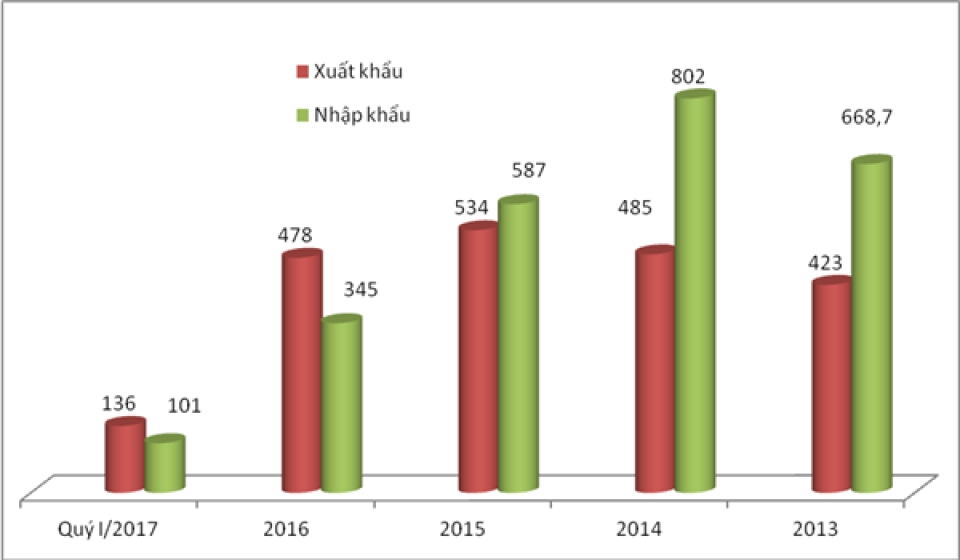COMMODITY GROUPS SUBJECT TO PROCEDURES AT IMPORT BORDER GATES ARE HIGH RISK GOODS
VCN- The Prime Minister has just signed Decision No. 15/2017 / QD-TTg of 12th May 2017 promulgating the list of imported goods subject to Customs clearance at the import border gate, including 17 sensitive commodity groups with a high risk level (such as tax administration, specialized management, security, national defense, environment etc.) which need to be strengthened at the border. How will the new regulation change Customs procedures of enterprises?
 |
| Import-export activities at Da Nang port. Photo: Ngoc Linh. |
On 21st January 2015, the Government issued Decree No. 08/2015 / ND-CP detailing and implementing measures to implement the Customs Law on Customs procedures and Customs inspections. Accordingly, Clause 2, Article 4 stipulates: “Based on the situation of export and import in each period, the Prime Minister shall decide on the list of imported goods subject to Customs procedures at import border gates.” In accordance with the Customs Law 2014, Clause 2, Article 4 of the above-mentioned Decree No. 08/2015 / ND-CP, the Ministry of Finance has already reported and submitted to the Prime Minister for promulgation of Decision No. 15/2017 / QD-TTg of 12th May 2017 on the list of goods subject to Customs procedures at import border gates, including 17 sensitive commodity groups with a high risk in management (such as tax administration, specialized management, security, national defense and environment) which need to strengthened at the border.
These goods include: (1) Cigarettes, cigars and other preparations of tobacco for smoking, snoring, chewing and snuffing; (2) alcohol; (3) beer; (4) passenger cars of less than 16 seats; (5) Two-wheeled or three-wheeled motorcycles with a cylinder capacity of over 125 cm3; (6) Aircraft and yachts; (7) Gasoline of all kinds; (8) Air conditioners of 90,000 BTU or less; (9) playing cards; (10) Joss papers; (11) Goods subject to animal quarantine according to the list prescribed by the Ministry of Agriculture and Rural Development; (12) Goods subject to aquatic product quarantine as stipulated by the Ministry of Agriculture and Rural Development; (13) Goods subject to plant quarantine according to the list prescribed by the Ministry of Agriculture and Rural Development; (14) Explosive substances and explosive pre-substances in accordance with the list prescribed by the Ministry of Industry and Trade; (15) Goods affecting security and the national defense according to the list as prescribed by the Ministry of Industry and Trade; (16) Scrap on the list prescribed by the Prime Minister; (17) Goods subject to self-defense, antidumping, anti-subsidy taxes in accordance with regulations of the Ministry of Industry and Trade.
Commodity groups from (1) to (10) are on the list issued with the HS code. For commodity groups from (11) to (17), the HS codes shall be declared and promulgated by the Prime Minister and the specialized management Ministries.
The Decision has also specified various kinds of goods (on the List and not on the List) and the same bill of lading which is subject to Customs clearance at the border gate.
However, with the aim of encouraging enterprises to develop production and facilitate some cases of special-purpose imports, the Decision has also stipulated that imported goods belonging to the list may be conducted Customs procedures at the border gate or other places in the following cases:
First, equipment, machinery and materials imported for the construction of factories or works are subject to Customs procedures at customs offices directly managing factories and warehouses.
Second, raw materials, supplies, equipment, machinery, components and spare parts used for processing and production shall be cleared from Customs offices where the plants or production facilities are located.
Third, temporarily imported goods for participation in trade fairs, exhibitions or product introductions shall be subject to Customs procedures at Customs offices where fairs, exhibitions or products display.
Fourth, the imported goods in the duty-free shops shall be conducted Customs procedures at the customs offices that directly manage the duty-free shops.
Fifth, the goods imported into the non-tariff area shall be conducted Customs procedures at the Customs office managing the non-tariff area.
Sixth, imported goods for emergency aid under Clause 1, Article 50 of the Customs Law shall be transported to places where natural calamities or epidemics occur or emergency relief is requested.
Seventh, specialized goods used for security and the national defence according to the provisions of Clause 2, Article 50 of the Customs Law shall be conducted Customs procedures at Customs offices at the request of the Customs declarants.
Eight, gasoline is taken from the bonded warehouse to the Customs clearance sites where the trader operates a petroleum storage system.
Nine, the imported goods in the same container are cleared at the Customs office managing the retail place.
Ten, other cases as decided by the Prime Minister.
The Prime Minister has assigned the Ministry of Finance to direct the Customs offices to intensify the control high-risk imported goods in the management, ensuring the requirements of tax administration, the national defence and security and the quality of goods on the list of imported subject to Customs procedures at the border gate. This decision comes into effect on 1st July 2017.
By Viet Ha/ Hoang Anh
Source: http://customsnews.vn/













